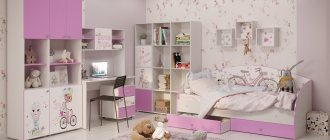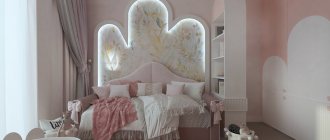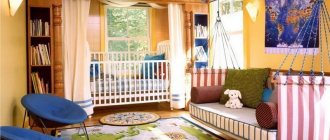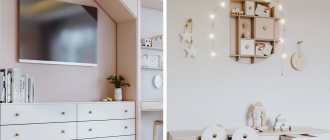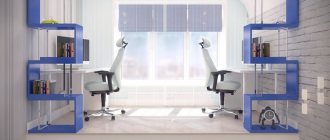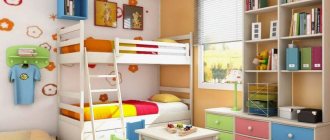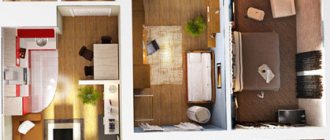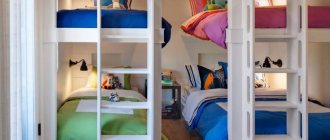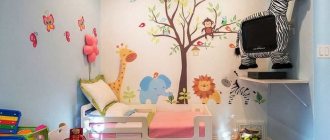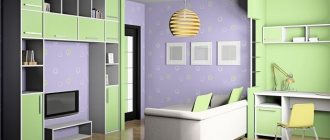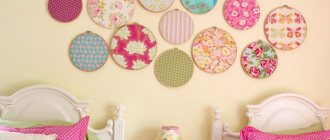Sometimes living conditions do not allow for a spacious room for a children's room. But even in a small room with a modest area, it is possible to rationally use the space and create a cozy, original and functional interior. There are many effective techniques that can save square meters so that the design of a small children's room includes everything a child needs and still has enough space for games.
By the way, in small and cozy rooms, children often feel more comfortable than in huge and faceless mansions. Take note of useful recommendations for arranging a small children's room and feel free to start organizing an individual space for your growing personality.
Which style is best?
For small children's rooms, you need to apply those stylistic trends that are characterized by predominantly light and soft shades.
The most popular styles in interior design for children's rooms with a modest area:
- classical;
- modern;
- Scandinavian;
- nautical;
- Provence;
- loft.
In the classic version, the interior is done in soft colors, with the addition of elegant patterns, wooden furniture with gilded or silver details. For a girl, decor in soft bed colors is suitable; a boy should add blue, gray or beige palettes.
Children's rooms in a modern style are presented in a monochromatic design, sometimes with the addition of discreet geometric prints. Correct, clear, lines without many decorative details, the result is a restrained and laconic interior, which is distinguished by a special order and neatness. This indoor design is more suitable for children over 10 years old.
Scandinavian-style rooms create a bright, fresh and pleasant atmosphere that evokes a beautiful, snowy winter. The Nordic interior emphasizes the abundance of snow-white, soft blue, pastel gray shades, with the addition of bleached wood furniture and thematic decorative details. In such a pleasant room both teenagers and newborns will feel comfortable.
The blue and white color scheme with small accent red details is typical for the nautical style. Models or pictures of yachts, lighthouses and ships, lifebuoys, anchors, steering wheels, compasses, images with underwater landscapes and sea animals are used as stylistic decoration. Curtains can be selected so that they resemble sails as much as possible and can be tied up with ropes with beautiful nautical knots.
Romantic, floral motifs of Provence are usually used in the design of rooms for girls of all ages. And sports equipment, photo wallpapers with large cities and sports cars fit well into the slightly casual atmosphere of a boy’s room decorated in a loft style.
Color solution
In a small room you should not use a large abundance of colors. The main color scheme should be neutral, harmonious and moderate. Walls, floors, ceilings and furniture are selected in a calm and discreet palette. Textiles and small stylistic elements will serve as decorative accents.
White color in the interior is successfully combined with all possible shades. It also has the ability to visually expand space in small rooms. Therefore, it can be safely used as the main tone.
The beige palette is appropriate in children's rooms for girls and boys. This cozy and elegant color goes well with pink, blue, green, and harmonizes perfectly with natural wood and gold-plated, silver details.
Sunny yellow has the ability to charge with positive energy and stimulate mental activity. A successful combination of yellow with green, gray, white, blue and pink shades of equal saturation. The natural purity of green gives a feeling of security and peace. It can be combined with yellow, pink, brown, purple, turquoise, gray, white.
Pink is popular in girls' children's rooms; it harmonizes perfectly with all pastel shades, as well as chocolate and light green. Blue is equally appropriate in boys' and girls' rooms. The most spectacular companion for him is white. However, blue also works quite well with yellow, beige, and pink palettes.
Materials and finishing
In a children's room, it is important to use environmentally friendly materials that will not cause any harm to health, will be durable, practical and aesthetically attractive. Therefore, you should approach your choice carefully and carefully.
Floor
For flooring in a children's room, it is best to use natural wood, laminate, or cork floors. Linoleum and self-leveling mixtures should be ignored. Slippery surfaces often lead to injuries; this must be anticipated and avoided.
Walls
Light walls will add space to a small room. They can be painted, decorated with wallpaper or decorative plaster. The main thing is that the materials used comply with sanitary and hygienic requirements and are allowed for use in children's premises. You can also visually expand the space using photo wallpaper with perspective. For example, depicting a natural landscape with paths stretching into the distance.
Ceiling
For finishing ceilings in small children's rooms, light whitewash is ideal. You can also use high-quality glossy stretch ceilings, which can visually lift walls in low rooms. Two-level plasterboard structures are quite appropriate to obtain additional volume.
Textile
Textile design should consist of safe, hypoallergenic fabric materials. Curtains can be purchased from linen, cotton, or you can add light translucent tulle. It is advisable to select bedding in delicate and soft shades so that they harmonize as much as possible with the main interior design. It is better to avoid woolen carpets in favor of light, short-pile carpets.
Ways to visually expand space in small rooms
If it is impossible to expand the living room through redevelopment with the demolition of interior partitions, you will have to limit yourself to visual effects. Every centimeter of the living room, regardless of the interior design of 15 sq.m., must be distributed according to the functional load. The choice of visual expansion methods must be justified.
Photo wallpaper with a 3D effect will help you “pull back” the wall a little or “demolish” it, revealing a panorama of the city blocks of New York or the capitals of the Old World.
Attention! The wall with photo wallpaper should be open - there is no point in blocking the panorama with a sofa or computer desk. But you can play up the image with a fake fireplace or steps if this complements the effect of the plot.
On the free wall behind the sofa you can place decorative panels, wallpaper with optical illusions or large patterns. A voluminous rose in light shades or a large-scale portrait of an idol will visually expand the space.
Horizontal and vertical linear contrasts are another way to “enlarge” a small living room. It’s good when lines of the same width and shade pass through the floors and walls (or ceiling). A black plinth and cornice on the ceiling expands the perimeter of the planes, but this should go well with the decor and textile pattern.
Glossy finish, regardless of shade, plays well with the task of expanding the interior of a living room of 15 sq.m. For example, a white suspended ceiling or the facade of a built-in wardrobe will add reflected light and visually elongate the room.
Mirror surfaces are the best method of “doubling” space, but they need to be used wisely. You cannot place mirrors opposite each other and on the opposite side to the window (another bright source of light).
It is advisable to combine:
- black varnish self-leveling floor (looks extravagant and does not absorb light);
- mirror wall;
- narrow plastic panels with a high degree of light reflection;
- mirror tiles (from different materials);
- mirrors on interior doors and cabinet furniture.
These techniques will not only “add” light, air and space, but will also solve purely functional problems, saving square meters.
It is important to follow the golden rule:
Regardless of the size, it is important to maintain clear passages so that the room does not seem cluttered and “impenetrable.”
Furniture and ways to save space
There are many different combined, multifunctional furniture on sale, which are designed to save space in small rooms. One two-tier structure can combine a sleeping area, a workplace and a wardrobe, and it will occupy only one wall or part of it. In this case, there will be a loft bed on top, a desk with shelves for stationery under it, and compact wardrobes on the sides. Also, a bunk bed connected to a rack or closet will provide two children with sleeping places and shelves for storing things.
Pieces of furniture in small children's rooms are placed close to the walls to free up a larger area for the play area.
In furniture stores it is not difficult to find many interesting ideas for saving space. In some cases, you can make your own sketch, according to which a multifunctional furniture structure will be made to order. Folding tables, which open only during classes, will also not take up unnecessary space. Shelves placed under the ceiling will be difficult for a child to reach, but they can be used for long-term storage of items that are not used daily. It is convenient to place clothes for growth, spare blankets, bedding sets and much more. Take a closer look at combined furniture structures that will allow you to provide your child with everything they need at a minimum cost of space.
General principles for planning a small children's room
Children's rooms have a universal purpose: here the child plays, studies, sleeps, which is why their layout is based on zoning, but in a very small children's room it can be very conditional - there is a play area on one wall, a work area on the other, and a bed on the third. Any partitions, even low ones, or dividing space with furniture in a small room are meaningless - they simply will not leave any useful space.
Based on this, it is necessary to allocate an area for night rest, and then, in accordance with age and individual needs, areas for games, sports, study, daytime rest - but in total there should be no more than three or four.
Layout of a narrow children's room
The difficulty of a small room is that it is difficult for a child to concentrate on one activity. There are a lot of distracting objects around, very close by. I sat down to draw and there was a bright book next to me. Doing her homework, her favorite doll just looks into her eyes. I sat down at the synthesizer - the physics textbook on the shelf reminded me of the upcoming exam.
The main task of zoning a small child’s room, especially a schoolchild’s room, is to ensure that only what is directly related to his occupation falls into the child’s field of vision; all the features of the layout are connected precisely with this.
As already mentioned, in a tiny nursery, zoning “around the perimeter” is the most common, but not the only one.
Two-story play corner
A small nursery for a baby - no surprises
No matter how cramped the room may seem, you can turn it into a comfortable nursery for a baby or preschooler.
There are no problems for the baby - a changing table in a bright place, a crib against the wall where direct sunlight does not fall, a small chest of drawers and a basket with a lid for dirty laundry - that's all the baby needs. It would be great if there was also a chair for a nursing mother. A baby rug and large boxes of toys are what he will need very soon, but there is always enough space for this.
When the child gets on his feet and masters the basics of independence, there are usually no big difficulties with planning either, but by this time the children's room for a small child must be designed so that he can distinguish the purpose of different zones.
Classic nursery layout
The bed and chest of drawers are where he gets ready for bed and gets dressed when he wakes up. Low cabinets, shelves or chests are houses where toys are hidden at night, so that in the morning they can play with him again on the rug. And finally, a small children's table with a chair is a prototype of the future workplace, where the baby will learn the first skills of drawing, looking at books and making pyramids. By this time, mom's chair is usually moved to another room to make room for games.
Often in the nursery there is a high cabinet or shelf at an inaccessible height - there the mother stores useful ointments, dangerous bottles and various small things with which she treats, cleans, and combs her child’s hair. For a small nursery, a shelf is preferable - it does not take up space and is safer in terms of limiting access to medications.
No matter how small the children's room is, its layout must include a mini sports corner; they can be very compact, 80x60 cm.
The color scheme is soft pastel shades with the inclusion of several bright accents - they can be curtains, furniture, or a rug.
Layout in the form of a labyrinth
Secrets of planning a nursery for a primary school student
Features of the layout of a small children's room for a primary school student are related to the fact that he needs to learn to clearly divide time for play, rest and time allocated for doing homework. Even if the room is small, its zoning should be done in such a way as not to distract the child from his lessons. Therefore, the key isolated zone is the work zone - compact, but sufficiently isolated from others.
A low podium by the window will help to emphasize the special status of the work area, the space under which can be used for storage systems.
Sometimes, to save space, the work area is located under the bed, located in the second tier - but in this case it is difficult to provide sufficient natural light.
It is reasonable to position the table “facing” a window or wall, so that the child has racks and shelves with textbooks in his field of vision, and the play area remains behind him. It is also very important for a primary school student that the table and chair are suitable for his height and are comfortable. It would be good if all the furniture in the work area - table, chair, shelves and racks - were from the same set or in the same color scheme.
World map instead of wallpaper
By this age, the night zone may remain the same, but due to a lack of space, it may undergo significant changes. Starting from the age of six, you can use bunk beds, or those in which the sleeping place is on the second tier, and the first is used as a relaxation area or for storage systems.
In the play area, not only low storage systems - chests and low bedside tables - are suitable for storing toys. The child is dexterous enough to use the top shelves, so tall narrow cabinets, racks and wall shelves become popular.
A very important point: when planning a small children's room, do not try to use furniture of standard depth - 45 and 60 cm. For children's things on hangers, a cabinet depth of 50 cm is sufficient, and if they are located on perpendicular racks, even less. For books and toys, as a rule, a shelf depth of 17-20 cm is sufficient. Reduce the depth of the furniture, even if this means making furniture to order - only due to the optimal depth of cabinets and shelving, you can increase the free space in a small nursery by one and a half to two times .
The color scheme, as well as accessories, must be chosen together with the child - let this be his first serious experience in decorating his home.
Game corner
Small room for a teenager
Of course, I would like to renovate the room and forget about it for the next 10 years, but this is not possible with a nursery. The child grows, by the fifth grade he becomes cramped at the children's study table, unless he is transforming, growing with the child. In addition, the room is filled with equipment that was not there before - a computer, audio systems. Where should I put all this?
The computer takes a strong place in the updated work area. The playroom disappears from the teenager’s room, and its place is taken by a recreation area. There is a sofa for guests, and music and video equipment. The bed is either located on the second tier, or it is a folding sofa, which is not very good for a developing organism.
A teenager’s small room, which he no longer agrees to call a nursery, needs a new layout and a fresh style design.
Children's room for homework
Together with your older child, make a drawing, outline a new layout, decide which design style to choose and which furniture needs replacing. Furniture often has to be changed completely - this is due both to the fact that it must have “adult” dimensions and to a new interior design.
Teenagers, as a rule, choose a bold, often shocking, design style - loft, hi-tech, minimalism. Girls may like Provence or Art Deco. All these styles can be implemented in a small room, and in different budget ranges.
A loft in a small children's room does not have enough space, but you can make a new layout - move the bed to the second level, make a podium for a work area by the window, remove cabinets and replace them with hidden storage systems, and place a sofa and equipment in the center of the room. Imitation of rough brickwork on the walls and posts will complete the loft-style design.
Layout of a children's room for a boy
Provence looks great in a small room: sunny pastel colors, small and large floral patterns in textiles, light, “faded” furniture, white walls - such a room will make a teenage girl happy. So does the Art Deco interior. Despite the “rich” appearance, such renovations will not cost much – the style will be created by spectacular wallpaper, vintage accessories, and the predominance of white will fill a small children’s room with air.
Both Provence and Art Deco are chosen exclusively by girls, while loft, high-tech and minimalism are unisex styles; all teenagers like them.
Since in a small room the possibilities for using space are limited, the emphasis is on stylish accessories, colors, and decoration. Don’t be afraid to overdo it, to exaggerate the colors – a little theatricality and play in a teenager’s room won’t hurt.
Multi-tiered layout to save space
Lighting organization
For an artificial lighting source in a children's room, it is good to use LED bulbs in the yellow and white spectrum. They distribute soft and diffused light and are not hazardous to health. Incandescent lamps emit radiation as close as possible to sunlight and are perfect for lighting in children's rooms. Bright neon sources can be irritating to children. Fluorescent fluorescent lamps containing mercury should not be used in residential premises at all.
The brightest light source is located above the playing area. A pendant lamp is placed at the desk so that the light falls on the surface from the left side or a table lamp is placed. You can install a sconce or an original night light by the bed.
Small children's room for two owners
Accommodating two children on eight square meters is not an easy task, but if life dictates such conditions, it is doable.
For children over 6 years old, actively use the second tier. If the ceiling height allows (more than 2.5 meters), two sleeping places can be placed on the mezzanine. Then the vacated area will accommodate everything you need - two workplaces and a common recreation area.
For babies, two cots will be required, but the play area can be shared.
Room layout for two children
Design of a children's room 5-6 sq.m.
In tiny rooms ranging from 5 to 10 square meters, organizing space for one child is not so difficult. It is much more difficult to fit into one such room everything necessary for two growing residents. Here you will need to use ingenuity and use non-standard solutions.
The decoration should contain exclusively light shades. If you want to decorate your walls with wallpaper, you should choose plain wallpaper or with small, unobtrusive patterns and prints. Because large bright elements can make the room feel more cramped. You can try to match the furniture to match the finish or choose products in a universal white color. Curtains should also be light.
A sleeping area is organized against one wall. The space between the floor and the bed is often rationally used to store some things. Drawers can be installed under the bed. The work area will be located near the window. To store things and save space, you can use corner furniture structures, cabinets, shelves, and study corners. If two children live in a room, folding, retractable or folding tables for study sessions would be a good solution. Shelves are additionally installed on the walls, above windows, and doors. The decor will be pillows, bedspreads with prints, patterns or images and photographs in cute frames.
Furniture arrangement
If a room is being organized for two school-age children, it is important to correctly position the desk at which students will do their homework and creative work. The most practical option is to place the table near the window. In this case, children will be able to write and draw in sufficient natural light.
In a room without a window, you will have to think about not only the location of the table, but also bright lighting, which will allow the child to do his homework without straining his eyes.
The next important step is to allocate space for the bed. If the room is intended only for a boy or only for a girl, the sleeping place can be placed next to the desk. For two children you will have to purchase a bunk bed, since the room is 6 sq.m. two beds won't fit.
After arranging the table and bed, the remaining space can be filled with open shelving where the child will store toys. For boys and girls who no longer play with toys, shelving can be used to store books, personal items, photographs, and handmade items.
Thus, the design of a children's room is 5 sq.m. or 6 sq.m., it can be made beautiful. The main task in this matter remains the creation of a cozy and safe space in which the baby will feel as comfortable as possible.
When choosing furniture, it is recommended to opt for multifunctional models that can last for several years in a row, taking into account the growth and development of the child. The color scheme for a small room should be made in light colors, a pastel palette. Considering these recommendations, organizing the interior of a children's room will not be difficult.
Design of a children's room 7-8 sq.m.
To organize a room of 7-8 square meters, the same techniques are used as described above: light colors, multifunctional furniture, a minimum of decor. But I would like to add that it is preferable to choose bedside tables, bookcases, wardrobes and chests of drawers not in standard sizes, but in smaller, compact sizes. For example, for a rack, a depth of 28 cm would be more optimal, rather than the standard 36 cm. Or, for a small room, it is more logical to purchase a compact chest of drawers with a depth of 45 cm, rather than 60 - 75 cm. When choosing a cabinet, give preference to a model with sliding rather than hinged doors. Every centimeter should be managed rationally, so feel free to use all sorts of tricks and techniques.
Design of a children's room 9-10 sq.m.
In rooms of 9-10 square meters, which are often found in Khrushchev-era buildings, you can decorate three walls in light, delicate colors, and make the fourth an accent wall by decorating it in a more saturated color with prints, or place photo wallpaper with a perspective. If the ceilings are low, vertical stripes or patterns on the wallpaper will help to visually raise them. But this technique can be used in square rooms, in long rooms similar to a pencil case; vertical stripes on the walls will make the room even narrower. Choose simple curtains, without unnecessary ruffles or draperies. And of course, take on board useful tips for saving space.
Design of a small nursery for a boy
In a boy's small room, simple color combinations based on white, blue, gray, and green are suitable for decoration. If a loft style is planned for the nursery, then one wall can be imitated to resemble a brick or concrete surface. The decor will be textiles, pillows, bedspreads, images and small details corresponding to, for example, a marine or other chosen theme.
Narrow bedroom layout
The main requirement for a small room is the correct installation of the bed.
Everything else is already a trifle. But if your bedroom is long, things get more complicated. It is necessary to choose the largest bed that the room can accommodate.
It can be installed across the room or along long walls. To do this, proceed from the size of the bed and bedroom. For a double bed, leave passages of at least 70 cm to both places and install it along the wall.
The disadvantages of this layout include the inability to place other pieces of furniture in the room: a wardrobe, a chest of drawers, a dressing table. If you need to place a large number of interior items, install the bed across. In this case, both passes or one to the far one are preserved. Otherwise, one person will have to jump over the other every time to lie down in their place.
Make sure you have space to store personal belongings and bed linen. To do this, use the wall at the head of the bed. Place hanging shelves and cabinets in a U shape. For a compact bedroom, this is a convenient and functional solution.
If the room has a niche, place a wardrobe with mirrors there, which will visually expand the space.
Design of a small nursery for a girl
A girl's room will be more appropriate in delicate berry, cream, green, yellow, and beige shades. Decorative pillows and elegant bedspreads with floral or ornate patterns will make the room more interesting and attractive. The bed can be complemented with a canopy, which will allow you to comfortably retire and be alone with yourself. Separate hangers will help you neatly place more clothes. A soft ottoman is suitable for storing various items; in addition, it will be comfortable to sit on. You can refresh the room with fresh flowers.
Let's sum it up
In conclusion, I would like to once again highlight the main techniques for saving space in small children's rooms:
- soft light colors should prevail in the room;
- for furnishings it is better to purchase compact, multifunctional furniture, combined and corner furniture designs;
- Plain wallpaper or with small unobtrusive patterns is optimal;
- curtains should be of a simple cut;
- photo wallpapers that depict natural or city landscapes with paths going deep into the interior visually add space;
- it is permissible to use a minimum of decorative elements.
Designers have implemented many successful projects for small children's rooms, where they managed to rationally distribute space and achieve maximum comfort in the room. The recommendations outlined above will help you properly arrange a small room, make it functional, comfortable and stylish.
What really matters
In dreams, everyone sees their beloved child’s room as spacious, bright, with magnificent, comfortable furniture and bright accessories. When it comes to a small room, it is especially important to decide what is really important for the good development of the child, and what is of secondary importance.
Let's try to highlight the points that need to be taken into account in order to develop the optimal layout of a children's room, even if it is small. Let’s be clear right away that they often conflict with each other, and the decision you make will reflect your personal priorities in matters of raising children.
Swing in the children's room
Health
The health of a child who spends most of his time within the walls of a small nursery is most affected by the environmental friendliness of materials.
The choice of furniture, finishing materials, floor and ceiling coverings should be taken especially carefully. No matter how you ventilate the room, if you use synthetic materials that are not recommended for children’s rooms - plastic panels, cheap linoleum, polyvinyl chloride, chipboards, vinyl wallpaper - the concentration of harmful substances in the air may exceed permissible standards.
Children's room in warm colors
Materials that can be safely recommended for a nursery are high-quality linoleum, laminate, wooden parquet, for example carpet, provided that it is very easy to clean and wash. On the walls and ceiling - paper wallpaper or painting with water-based paints.
Furniture is preferably made of solid wood. It is not necessary to use expensive types of wood; pine and birch are an excellent alternative for a nursery. Metal beds are coming back into fashion - openwork, thin, they bring light airiness to a small child's room and are absolutely safe from an environmental point of view.
Large window in the nursery
Psychological comfort
The psychological comfort of children depends not so much on the layout of a small children's room, but on the degree of illumination and aesthetics.
The smaller the window in the nursery, the more significant is its immaculate cleanliness and the transparent weightlessness of the curtains. Partitions that shade any corner of the room are not welcome. Natural sunlight is an essential condition for healthy development, physical and mental.
Color plays a big role in creating a child-friendly atmosphere. The absolute favorites for children are clean, light pastel colors.
Indian style in the design of a children's room
Purity
Lightly cleaning the room teaches children to be clean much more effectively than edifying conversations and the persistence of parents: this point must be taken into account when planning a small nursery.
When choosing finishing materials and furniture, evaluate how quickly they will get dirty, and whether it is possible and how easy it is to wash them - this is especially true for light-colored surfaces. We agreed to be realistic, right? Sometimes it is easier to achieve a feeling of comfort and order in a boy’s room by decorating it in dark colors, brown and blue. A bit dark? But this is much better than stained light walls and the grumbling of a mother armed with stain remover.
Saving space due to sleeping space
Development
The physical, aesthetic and intellectual development of a child depends on the layout of a small children's room.
To encourage a child to exercise and give an outlet for his energy, it is necessary to leave enough space for somersaults even in a small room, even at the expense of shelves and cabinets. Now you can find miniature but fully functional sports corners on sale, which are mounted, occupying half a square meter of area.
For intellectual development, you need a comfortable play corner and a table for reading, drawing and modeling, and schoolchildren need a work corner.
A thoughtful, stylish design of a nursery affects the child’s aesthetic development no less than children’s artistic activities, but a place must be reserved for it. In addition to the work table, you can install an “exhibition board” on one of the walls - a special perforated plate on which it is convenient to mount children’s drawings and crafts. For the little ones, many parents set aside part of the wall for drawing - in this case, until the child grows up, the white wallpaper (“canvas” for the first masterpieces) is re-glued as necessary.
Work area in the children's room
Safety
Safety in a small children's room implies, first of all, the absence of sharp corners and protruding fittings that could cause injury.
Considering that when planning a small nursery, the second level is often used, all stairs leading to the mezzanine or to the upper shelves of cabinets must be absolutely reliable.
Layout of a children's room in blue tones
